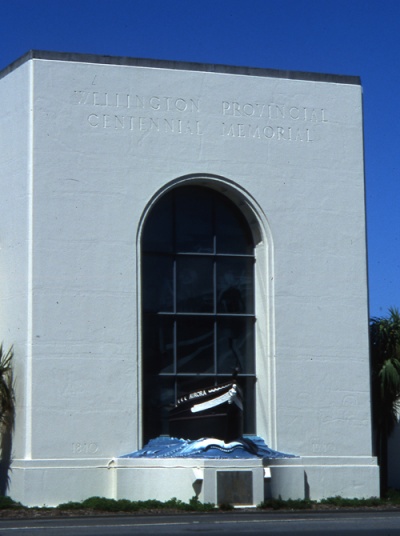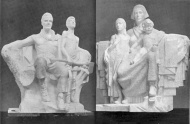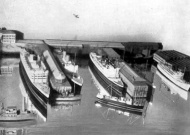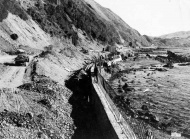Articles
The 1940 Centennial

The centennial celebrations of 1940 marked a century of European effort and progress. Maori history and the centenary of the signing of the Treaty of Waitangi took a back seat.
-
Page 2 – The Centennial Exhibition

The New Zealand Centennial Exhibition ran from 8 November 1939 to 4 May 1940. During this time 2,641,043 people went through the main gates with a daily average attendance of
-
Page 3 – Playland
Over the 1939/40 summer 2,870,995 people - 200,000 more than the total number who visited the centennial exhibition - spent their pounds and shillings in Playland
-
Page 4 – The Centennial and progress
The 1940 Centennial, planned for five years and publicly funded, was a deliberate act of national self-definition by the first Labour government.
-
Page 5 – The Treaty of Waitangi
Despite all the talk of the 'birth of a nation', the place of the Treaty of Waitangi or Māori in the centennial celebrations was less obvious.
-
Page 6 – Further information
Links and books relating to New Zealand's 1940 centennial
Centennial - growth of New Zealand identity

Between 8 November 1939 and 4 May 1940 more than 2.6 million people visited the New Zealand Centennial Exhibition in Wellington; this represents an average daily attendance of about 17,000 people. The government spent £250,000 – more than $19 million in today's money – on the exhibition.
-
Page 2 – Cabinet briefing paper - 1940 Centennial
When the Second World War broke out in Europe in September 1939 the question of postponing the Centennial Exhibition aroused heated debate among the public and in Parliament
-
Page 3 – Examining primary sources - 1940 Centennial
Promotional material from the Centennial Exhibition, 1940 provides useful information about New Zealand's values, its people and about itself as a nation at that time.
-
Page 4 – Letter to the editor - 1940 Centennial
Not everyone agreed with the idea of the centenary celebrations in 1940. Here is your opportunity to consider some of the arguments against the commemorations by writing a
-
Page 5 – The centenary in your area - 1940 Centennial
The government emphasised the construction of public monuments during the 1940 Centennial. Do some research to find the monument to the 1940 Centennial in your area.
-
Page 6 – Essay writing - 1940 Centennial
Write an essay about the ways in which an individual or group identity has been formed or has developed.
-
Page 7 – The 1940 Centennial and the Treaty of Waitangi - 1940 Centennial
The year 1940 marked 100 years since the signing of the Treaty of Waitangi. Yet critics of the centenary celebrations argued that the Treaty and Maori played little meaningful
-
Page 8 – Sound and film interpretation - 1940 Centennial
Visit the media gallery for the feature on the Centennial Exhibition where you can listen to sound files associated with the exhibition that were recorded between November
Waitangi Day

Every year on 6 February, New Zealand marks the signing of the Treaty of Waitangi in 1840. For most people, Waitangi Day is a holiday; for many, and especially for Māori, it is a time for reflecting on the Treaty and its place in modern New Zealand.
- Page 3 - Waitangi Day 1940s-1950sFrom the 1940s the Treaty and Waitangi began to find a place in the national consciousness. For most New Zealanders, they were of historical interest
Treaty timeline

See some of the key events between 1800 and 1849 relating to the Treaty of Waitangi.
- Page 3 - Treaty events 1900-49Discover some of the key events between 1900 and 1949 relating to the Treaty of
Treaty signatories and signing locations

The Treaty of Waitangi was signed on nine separate sheets by more than 500 Māori. Find out more about the sheets, the signatories and the signing locations
- Page 6 - Preserving the documentsThe Treaty of Waitangi is kept in the Constitution Room at Archives New Zealand in Wellington. It has not always been so secure. Water, time and rodents have all taken a toll on
Related keywords
- wellington city
- lower hutt
- petone
- pioneers
- historic places
- memorials
- sheep
- sesquicentenary
- exhibitions
- historical writing
- centennial exhibition
- treaty of waitangi
- maori
- lord galway
- rongotai
- workers rights
- celebration
- playland
- sculpture
- william trethewey
- shipping
- roading
- waitomo caves
- railways
- poster
- waitangi day
- cartoon
- ngapuhi
- waitangi
- apirana ngata
- haka
- william hobson
- conservation
- thomas hocken
- national identity
- royal tours
- race relations
- 1950s
- rua kenana
- wiremu pomare
- tahupotiki wiremu ratana
- timeline
-
Main image: Wellington Centennial Memorial Building
This stark white memorial set in concrete on the Petone foreshore is an enduring celebration of Wellington's Pākehā pioneers.












